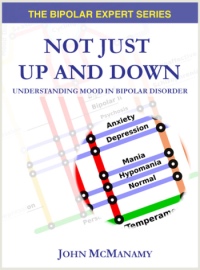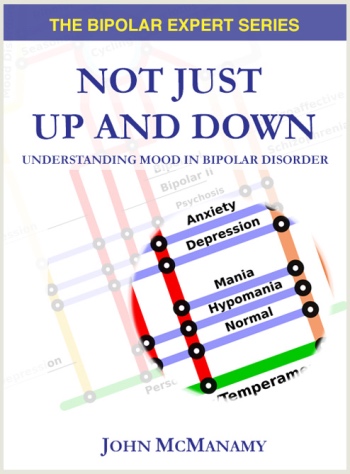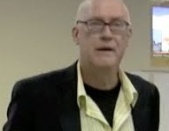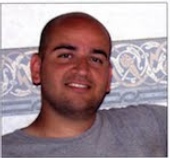Bipolar - Sharpening the Diagnostic Picture
 |
Does the DSM provide an accurate portrait? The short answer is no.
|
Bipolar disorder symptoms. In "Silence of the Lambs," Hannibal Lecter made reference to "garden variety manic-depressives." The DSM-IV is all about garden variety. Either we're dancing on tables or can't get out of bed.
But what about if you are depressed, yet want to scream and wring someone's neck? Depressed people aren't supposed to feel like that, are they?
For that matter, maybe you want to scream and wring someone's neck while you're dancing on that table. This can't possibly be mania or hypomania, can it?
My New Book!

Purchase now.
And suppose you've just been crowned King of Antarctica. You're elated, of course, but you feel a depression coming on.
Garden variety? Dr Lecter, bite your tongue!
With this in mind, in 2004 the International Society for Bipolar Disorders (ISBD) convened a task force to identify areas of consensus and controversy, with a view to guiding the planned revisions of the DSM and ICD.
The task force was headed up by Nassir Ghaemi MD of Tufts University, with eight subgroups assigned to specific areas. In 2006/2007, the task force subgroups submitted their respective articles to the ISBD Journal, "Bipolar Disorders." All but the work of the subgroup investigating mixed states survived the editorial approval and peer review process.
The Feb 2008 Bipolar Disorders devoted itself entirely to the efforts of these subgroups, with commentaries that might pique even Dr Lecter's interest. Without further ado ...
Mania and Mixed Mania
The authors in the pure and mixed mania subgroup included Frederick Cassidy MD of Duke University, Lakshmi Yatham MD of the University of British Columbia, Michael Berk MD, PhD of the University of Melbourne, and Paul Grof MD, PhD of the University of Toronto.
In their review article, the authors note that despite mania conjuring up the prototypic image of grandiosity and euphoria, more common "are manic patients displaying prominent irritability and psychosis." Psychomotor pressure is central to both pure and mixed mania.
Mixed mania may be thought of as a train wreck between depressive and manic episodes, but there also exists the possibility of "state" meeting "trait." Citing the pioneering diagnostician Emil Kraepelin and Hagop Akiskal MD of the University of California San Diego, the authors explain that mixed symptom patterns may result from the interaction between episode type (such as mania) and baseline temperament (such as dysthymic). Conversely, "pure" mania may result from mania developing over a hyperthymic temperament.
What little we know about the course of mania indicates that a history of mixed episodes may be predictive of future mixed episodes, though one study suggests that the earlier phases of mania may be characterized by elation and grandiosity, with dysphoric symptoms presenting later.
Gender in pure states is evenly divided, with females predominating in mixed states. Studies suggest that mania rates peak in the spring, though one study on a mixed population showed peaks in late summer/fall. Mixed states are more difficult to treat.
The DSM and ICD stipulate full-blown depression and mania for mixed manic states. Applying these thresholds, the authors note, results in much lower rates of mixed mania than in academic studies using less restrictive criteria.
Bipolar Depression
The authors in the bipolar depression subgroup included Philip Mitchell MD of the University of New South Wales, Guy Goodwin MD of Oxford, Gordon Johnson MD of the University of Sydney, and Robert Hirschfeld MD of the University of Texas Galveston.
The authors note that while elevated mood is the hallmark of bipolar, "syndromal or subsyndromal depression is now recognized to comprise the predominant cumulative effect over time."
Bipolar patients tend to present with depression first, with the age of onset earlier than for unipolar depression, and with more (and shorter) depressions over their lifetimes. There do not appear to be any differences in severity between bipolar and unipolar depression, but bipolar patients may experience more impairments, such as in memory and executive functioning.
Studies indicate that bipolar I depression is characterized by an admixture of melancholic (such as exaggerated worthlessness), atypical (such as weight gain and hypersomnia), and (less commonly) psychotic features, as distinct from "pure" melancholic and atypical depression.
According to a study by Gordon Parker MD, PhD of the University of New South Wales, patients with bipolar I depression were more likely to have had a past psychotic episode and to report worthlessness, anhedonia (loss of pleasure), restlessness, leaden paralysis, and hypersomnia than those with unipolar depression. Conversely, they were less likely to manifest tearfulness, anxiety, and to blame others. The most striking difference was that the bipolar group experienced greater psychomotor disturbances (such as slowing down in thought and movement, agitation, and cognitive dysfunction).
Studies on bipolar II patients conducted by Franco Benazzi MD, PhD of the Hecker Psychiatry Research Center (Ravenna) point to greater atypical features, but with no greater rates of psychomotor retardation.
An NIMH study found that four percent of unipolar patients graduated to bipolar I over 11 years. Nine percent converted to bipolar II.
Bipolar II
The authors in the bipolar II subgroup included Eduard Vieta MD, PhD of the University of Barcelona and Tricia Suppes MD, PhD of the University of Texas, Dallas.
The authors note that what is commonly regarded as "soft" bipolar is in fact "a severe pathology" that implies higher episode frequency, co-occurring ills, suicidal behavior, and rapid cycling than bipolar I. Compared to unipolar depression, those with bipolar II show a more chronic outcome and lower rates of recovery. Depression dominates over hypomania, by a ratio of 50-to-1 according to one study.
Not surprisingly, bipolar IIs tend to experience years of prolonged suffering due to misdiagnosis and improper treatment. One study found that 37 percent of bipolar patients had been misdiagnosed with unipolar depression at first presentation; another that only nine percent of bipolar II patients were accurately diagnosed. In a sample of patients diagnosed with unipolar depression, Dr Benazzi found that 45 percent actually had bipolar II.
The authors point out that standard diagnostic tools are deficient in picking up the full range of hypomanic symptoms. Moreover, individuals experiencing mild or moderate hypomania are not likely to interpret their condition as requiring help. Complicating matters is that dysphoric symptoms are often considered part of depression (often they are) rather than hypomania.
The authors make clear that hypomania is not just a light form of mania, as the DSM suggests. The DSM only recognizes euphoric hypomania, but this may not be its primary presentation. Patients manifesting the "dark" side of hypomania may show "dysphoric hyperactivity, anxiety, irritability, and depressive features emerging over a cyclothymic temperament." Mixed states may come into play (depression in hypomania), which may also apply to depression (hypomania in depression).
Bipolar II only achieved the same status as bipolar I with the 1994 publication of the DSM-IV. Prior to that, bipolar II was consigned to the dreaded NOS basket. The ICD does not recognize bipolar II.
The DSM-IV mandates at least four days of hypomania, but studies by Lewis Judd MD of the University of California San Diego lend credence to lowering the threshold to one or two days. In addition, Jules Angst MD of the University of Zurich has suggested that overactivity (such as goal-directed activity) may loom large in hypomania, despite any sign of obvious mood change.
Adopting broader criteria for bipolar II would raise current estimates of this population from one percent to three-to-six percent.
Studies indicate a genetic distinction between bipolar I and bipolar II. A study by Francis McMahon MD of the NIMH found that bipolar II sibling pairs showed strong linkage to the chromosomal region 18q21.
While bipolar I occurs with equal frequency in men and women, more women may experience bipolar II.
Citing a dearth of studies for treating bipolar II, the authors take issue with the FDA's position that what is good for treating bipolar I is good for treating bipolar II (but not the reverse), which discourages clinical trials for bipolar II patients.
The Bipolar Spectrum
The authors in the bipolar spectrum subgroup included James Phelps MD of Corvallis Psychiatric Clinic (Oregon), Jules Angst MD of the University of Zurich, Jacob Katzow MD of George Washington University, and John Sadler MD of the University of Texas Dallas.
The authors quote Socrates for the proposition that "we must only divide where there is real cleavage." Categories are useful to a point, the authors contend, but intermediate cases suggest "a continuous spectrum of bipolar disorders" stretching from unipolar depression to bipolar I.
The bipolar spectrum can also be taken wider and deeper to include: infrequent episodes and continuous cycling; pure states bleeding into varying degrees of mixed states; bipolar graduating into schizophrenia; and (more controversially) an overlap between bipolar and borderline personality disorder.
Last but not least, the spectrum can signify the continuum from normal to pathologic. The "lower border of bipolar II," for instance, has not been adequately addressed.
Various diagnostic schema for a bipolar spectrum include:
- A cyclothymia-bipolar spectrum (Akiskal).
- Bipolar subtypes along a spectrum (Angst).
- Greater number of categories (Klerman, Akiskal).
- New category of bipolar spectrum disorder (Ghaemi).
- Add minor bipolar disorders (Angst).
- 100-point bipolarity index (Sachs).
Although these schema differ in numerous respects, the authors point to a commonality regarding:
- Individuals with hypomanic reactions to antidepressants. (Two long-term follow-up studies found that 100 percent of these patients ultimately manifested overt bipolarity.)
- Subthreshold patients whose hypomania falls short of diagnostic cut-offs, but who clearly have more going on than simply major depression. (A recent National Comorbidity Survey reported a group of patients who did not meet bipolar thresholds, but whose disabilities equaled those of patients with asthma and diabetes.)
- Patients with no history of hypomania, but who show other indications of bipolarity, such as recurring depressions, family history of bipolar, and/or early onset. (Recurrent depression goes back to Kraepelin. Recent genetic research indicates an overlap between unipolar and bipolar.)
The authors suggest a "bipolar III" category that would include non-manic markers such as full major depression with subthreshold hypomania (accompanied by other indicators of bipolar). Alternatively, bipolar NOS could be widened to include bipolar III. Another option is "bipolar disorder without hypomania or mania." Another possibility is a "dimensional system" that would co-exist with the DSM categorical system.
The "categorical" view sees "nodes along a spectrum," which would call for more categories of the illness. The "dimensional" view sees the illness as a matter of degree, as in "how bipolar are you?" A further refinement to this is "probability," which looks at the question of likelihood (the bipolar depression subgroup took a "probablistic" approach).
Mixed States
The contribution from this subgroup did not make it into "Bipolar Disorders." Nevertheless, the obiter dicta from the above subgroups fill in some of the blanks, namely:
- The mania and mixed mania subgroup, taking a cue from Dr Angst, would use the following notation to define a single episode: Full depression, "D." Full mania, "M." Some depression or mania or mania symptoms, "d" or "m," respectively. Hence these varieties: D, Dm, DM, dM, M.
- The bipolar depression subgroup referred to "inside [major depression] hypomanic symptoms," including distractibility, racing thoughts, irritability, talkativeness, and risky and goal-directed activities.
- The bipolar II subgroup mentions "dysphoric hyperactivity" and "some hypomanic symptoms embedded in depression," together with the proposition that "mixed and agitated depressions might be better ascribed to the bipolar spectrum."
- The bipolar spectrum subgroup refers to a "possible continuum of mixed states."
In addition, the pediatric bipolar group (further below) raises the possibility of mixed states presenting as "chunks" of depression and mania in a way that may resemble very rapid cycling.
The DSM only recognizes mixed mania, in the form of full-blown mania occurring with full-blown major depression.
Rapid Cycling
The authors in the rapid cycling subgroup included Michael Bauer MD, PhD of Dresden University, Serge Beaulieu MD, PhD of McGill University, David Dunner MD of the University of Washington, Beny Lafer MD of the University of Sao Paulo, and Ralph Kupka MD of Altrecht Institute for Mental Health Care.
The authors point out that rapid cycling is a fairly new concept, first articulated by Dr Dunner and Ronald Fieve MD of Columbia University in 1974. The number four for the threshold requirement of mood episodes in a year was chosen arbitrarily. Treatment with lithium and other mood stabilizers tends to be problematic with rapid cyclers.
According to various studies, rapid cyclers comprise anywhere from 12 to 24 percent of the bipolar population, with females predominating. There are indications that rapid cycling has become more frequent in recent years, possibly owing to the widespread use of antidepressants. Rapid cycling can be induced by stimulants.
NIMH data reveals that patients who initially present with depression who show a predominantly depressive course experience greater rates of rapid cycling. Rapid cycling tends to be transient in most patients, though it can persist over years.
The DSM-IV requires a minimum episode length of two weeks for depression, one week for mania, and four days for hypomania. Cycling patients often manifest much briefer episodes not recognized by the DSM - ultra-rapid cycling (over more than a day) and ultradian cycling (less than a day). The rationale for excluding more frequent cycling from the DSM has to do with Kraepelin's view that mood volatility was par for the course for bipolar.
Schizoaffective Disorder
The authors in the schizoaffective subgroup included Gin Malhi MD of the University of Sydney, Melissa Green MD of the University of New South Wales, Andrea Fagiolini MD of the University of Pittsburgh, and Veena Kumari PhD of Kings College.
The authors note that Kraepelin made an historic distinction between what he termed manic depression (an episodic, relapsing, and remitting illness) and dementia praecox (an unremitting and progressively dementing illness), but that "in practice, many cases fail to qualify for either of these two diagnoses."
Genetic studies lend credence to an overlap between bipolar and schizophrenia, with a clustering of both in family groups, and shared suspect genes in both illnesses (one example is the DAOA gene on chromosome 13).
Schizoaffective was coined in 1933. The DSM-IV maintains that schizoaffective is distinct from both bipolar and schizophrenia, but acknowledges that there are no "absolute boundaries." Schizoaffective is thought to occur in less than one percent of the general population (women predominate), but the patient population is much higher owing to clinicians making the diagnosis when they are uncertain.
Schizoaffective is distinguished by the simultaneous presentation of psychotic symptoms with affective symptoms (eg hallucinations with depression), but there is disagreement between the DSM and ICD as to what precisely constitutes "simultaneous."
In schizoaffective, "there must be a mood episode that is concurrent with active-phase symptoms of schizophrenia." This is different than a "mood disorder with psychotic features" or "mood symptoms in schizophrenia." Not that it's easy to tell. Is a psychotic feature, for instance, congruent (more likely to be mood-related) or incongruent (more likely to be schizophrenia-related)? And is any given depression a mood disorder phenomenon or schizophrenia phenomenon?
Confounding matters is the discomforting reality that schizoaffective is a moving target - the relative proportion of mood to psychotic symptoms may change over the course of the disturbance, not to mention over the long term. Not surprisingly, most patients who receive an initial diagnosis of schizoaffective are later diagnosed with something else.
With all this in mind, the authors offer two alternative concepts:
- Schizoaffective exists as a co-occurring set of symptoms that is a byproduct of two separate disorders.
- Schizoaffective exists at midpoint on the continuum between bipolar and schizophrenia.
In either case, the authors would eliminate the designation, schizoaffective, in its entirety and substitute it with additional specifiers to schizophrenia, bipolar I, bipolar II, and major depression. Thus, in addition to the current DSM specifiers, schizophrenia would include:
- With symptoms meeting criteria for mania or mixed features.
- With symptoms meeting criteria for major depressive disorder.
And, in addition to the current DSM specifiers for bipolar I and II and major depression:
- With psychotic symptoms meeting Criterion A for schizophrenia (ie hallucinations or delusions over one month) and for at least two weeks without prominent mood features.
- With psychotic symptoms meeting Criterion A for schizophrenia with consistent concurrent mood features.
Pediatric Bipolar
The authors in the pediatric bipolar subgroup included Eric Youngstrom PhD of the University of North Carolina, Boris Birmaher MD of the University of Pittsburgh, and Robert Findling MD of Case Western Reserve University.
The authors note that the percentage of children diagnosed with bipolar has more than doubled in the past 10 years, fortunately coinciding with a surge of research. Disagreements abound, but "considerable evidence has amassed" supporting the validity of the bipolar diagnosis in kids.
Pediatric bipolar is associated with high functional impairment and low quality of life. The illness is identified with aggressive behavior, attention problems, anxious and depressed symptoms, delinquent behavior, social problems, withdrawal, and thought problems.
Irritability looms large as a symptom in kids. Although irritability (including aggression) is not specific to bipolar, its absence (unless other symptoms such as euphoria are present) may rule out a diagnosis. There is support for the idea that a state of chronic irritability may rate a diagnosis, even in the absence of obvious mood and energy swings, though the authors do not favor this view.
Other symptoms:
Some experts consider grandiosity a cardinal symptom, but this feature does not necessarily manifest in a good many youths with pediatric bipolar. Grandiosity may also be present in youths without bipolar. Nevertheless, fluctuations in self-esteem and grandiosity may be a dead giveaway.
Hypersexuality appears to occur in less than half the cases of pediatric bipolar, but it is rare (other than in cases of abuse) to encounter hypersexuality in other contexts.
Decreased need for sleep is also cause to consider bipolar.
One fifth of youths with pediatric bipolar experience hallucinations or delusions. Pediatric bipolar may be uncommon, but early-onset schizophrenia is even more rare.
Ultradian cycling appears to be the main point of departure from adult bipolar. Kids can literally switch from one extreme to another on a dime, but the authors note a distinction between cycling and an episode (which may encompass numerous cycles). In this light, kids may be seen as having mixed episodes, which may present as "chunks" of mania and depression over time (the "fudge ripple" effect).
Viewed this way, pediatric bipolar may not be all that different from adult bipolar (where mixed states are common).
Kids with bipolar experience high rates of co-occurring ADHD (broadly consistent with the pattern in adults), plus elevated risk of conduct disorder, substance use, and anxiety disorders (again, consistent with adult patterns).
The authors note that if pediatric bipolar may extend beyond strict DSM criteria, then so do many bipolar manifestations in adults (especially along a more broad spectrum). A lot of attention, they point out, focuses on apparent differences between the child and adult versions, but that "the growing expectation is that there will be considerable developmental continuity between pediatric bipolar disorder and adult presentations ..."
Final Word
In his introductory article, Dr Ghaemi points out that in the bipolar literature, treatment issues receive a lot more attention than diagnostic considerations. Yet, "in the practice of psychopharmacology, treatment decisions are often straightforward once diagnostic judgments are made."
The catch is that too many of us are doomed to ineffective and even harmful treatment due to poor diagnostic judgment. The next edition of the DSM, which is due out in 2013, unfortunately will far more closely resemble the present DSM and the DSM-III of 1980 than the recommendation of the ISBD group. We're on our own. Now, more than ever: "Know thyself."
Dec 25, 2008, reviewed Jan 5, 2011
 |
More articles on mood. |




